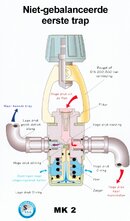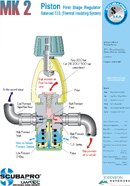Hi all, I just got a brand new Scubapro MK2+ from LDS and did a test to find out what
IP range it falls on and to understand its behavior. My test set up was an spg, an IP gauge connected directly to the 1st stage, and a 2nd stage for cycling/purging. To start, I cycled my reg a few times and then let it sat for a minute of two to make sure no creeping and then came back again to check it's final IP after x number of hours.
For those who are interested, my results are as follow:
Tank pressure, IP reading, Test duration, Observation
3000 psi, 135.0 psi, 6 hrs, OK
2250 psi, 132.5 psi, 13 hrs, OK
2000 psi, 132.5 psi, 13 hrs, Final IP = 129 psi, dropped 3.5 psi
1200 psi, 125.0 psi, 3 hrs, OK
1000 psi, 122.5 psi, 12 hrs, Final IP = 120 psi, dropped 2.5 psi
750 psi, 120.0 psi, 5 mins, OK
500 psi, 120.0 psi, 4 hrs, Final IP = 125 psi, creeped 5 psi
250 psi, 118.0 psi, 10 mins, Final IP = 120 psi, creeped 2 psi
Final IP readings were holding and they did not change further.
1. My IP range seems to be between 135psi - 120psi, a 15psi changed from 3000psi to
250psi tank pressure. Is this a typical profile for a new mk2?
On the low side, 120psi, it's out of the recommended IP range, is this still OK?
2. On the few tests where the IP dropped and creeped again, any explanation for
these behaviors and should I be concerned?
3. Looking at the total test hours, about 61 hrs, that is about 60 dives if an actual
diver spends 1 hr underwater and a whole year of diving if the diver dives once
every weekend. At about 47 hrs, when tank pressure was 500psi, the IP started
to show creeping, could this be an indication of the HP seat is getting worn from
long hours of compression? Again, this is just an assumption and could be far from
reality.
My testing wasn't very scientific but I thought it might be interesting to see some numbers. Please feel free to discuss. Thanks.
IP range it falls on and to understand its behavior. My test set up was an spg, an IP gauge connected directly to the 1st stage, and a 2nd stage for cycling/purging. To start, I cycled my reg a few times and then let it sat for a minute of two to make sure no creeping and then came back again to check it's final IP after x number of hours.
For those who are interested, my results are as follow:
Tank pressure, IP reading, Test duration, Observation
3000 psi, 135.0 psi, 6 hrs, OK
2250 psi, 132.5 psi, 13 hrs, OK
2000 psi, 132.5 psi, 13 hrs, Final IP = 129 psi, dropped 3.5 psi
1200 psi, 125.0 psi, 3 hrs, OK
1000 psi, 122.5 psi, 12 hrs, Final IP = 120 psi, dropped 2.5 psi
750 psi, 120.0 psi, 5 mins, OK
500 psi, 120.0 psi, 4 hrs, Final IP = 125 psi, creeped 5 psi
250 psi, 118.0 psi, 10 mins, Final IP = 120 psi, creeped 2 psi
Final IP readings were holding and they did not change further.
1. My IP range seems to be between 135psi - 120psi, a 15psi changed from 3000psi to
250psi tank pressure. Is this a typical profile for a new mk2?
On the low side, 120psi, it's out of the recommended IP range, is this still OK?
2. On the few tests where the IP dropped and creeped again, any explanation for
these behaviors and should I be concerned?
3. Looking at the total test hours, about 61 hrs, that is about 60 dives if an actual
diver spends 1 hr underwater and a whole year of diving if the diver dives once
every weekend. At about 47 hrs, when tank pressure was 500psi, the IP started
to show creeping, could this be an indication of the HP seat is getting worn from
long hours of compression? Again, this is just an assumption and could be far from
reality.
My testing wasn't very scientific but I thought it might be interesting to see some numbers. Please feel free to discuss. Thanks.





